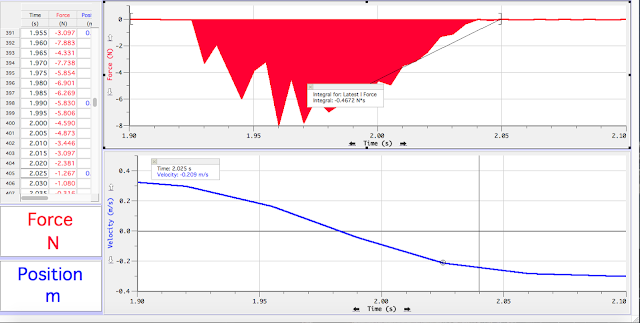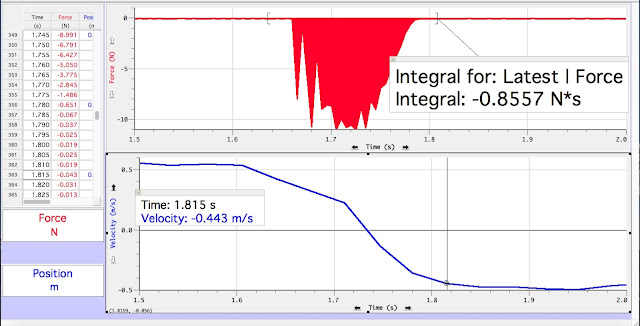Lab 14: Impulse-Momentum Activity
May Soe Moe
Lab Partners: Ben Chen, Steven Castro
19-April-2017
Objective: To observe and verify the impulse-momentum theorem
May Soe Moe
Lab Partners: Ben Chen, Steven Castro
19-April-2017
Objective: To observe and verify the impulse-momentum theorem
Introduction: According to Impulse-Momentum theorem, the change in momentum of an object equals to its net impulse. Momentum is when an object is in motion. Its equation is p=mv, where p is momentum, m is mass of an object, and v is the velocity of an object. Impulse is a force in change of time: J=FΔt. In this lab, we did 3 parts of experiments. One was elastic collision, where the moving cart with a spring plunger collides to the spring plunger of stationary cart mounted on a rod, which causes the moving cart bounced back. The second experiment was with the same set up but adding several hundred grams to the moving cart. For the third experiment, we set up an inelastic collision where the moving cart sticked to the clay and stopped. We would try to measure the impulse acting on the cart by taking the area under the force vs. time graph for the collision. We would also measure the change in momentum of the cart by knowing its mass and measuring its velocity before and after the collision using the motion detector.
Experimental Procedure:
Experiment 1: Observing Collision Forces That Change with Time
(1) We set up the lab by clamping a cart to a rod, which was also clamped to our lab table. We attached the spring plunger on the cart.
(2) We set up a track and put a force sensor on the another cart, attaching another spring plunger to this cart. At the end of the track, we set our motion detector.
(3) After this, we leveled our track to make sure the cart goes in a straight line at a constant speed when it is given a slight push. We calibrated and zeroed our force sensor.
 |
| Our apparatus for Experiment 1 and 2 |
(4) After all setup, we began to collect our data using Logger pro. When we heard the clicking of the motion detector, we pushed the cart toward the stationary cart.
(5) Let the cart move, collided, and bounced back. We repeated until we got good graphs.
 |
| Impulse= the integrated value of the area under the Force vs. time graph Initial Velocity |
 |
| Final Velocity |
(6) Now we can calculate the change in momentum since we know the mass of the cart, the final velocity and the initial velocity.
Comparison: When we compared the impulse--integrated value of the area under force vs.time graph and calculation of change in momentum, they are off by 13.7%. Our impulse was -0.4672 Ns and change in momentum was -0.350 kgm/s. Friction could have had some effects on the cart during its motion. May be the track was not re-level after each trial. But our percent error came out to be pretty large, therefore, the net impulse did not equal to the change in momentum from our results.
Experiment 2: A Lager Momentum Change
(1) This experiment was set up the same as experiment 1. But for this experiment, we added 200 grams to the cart and repeated the same steps in experiment 1.
 |
| Initial velocity |
 |
| Final Velocity |
Comparison: Our impulse from the area under the Force vs. time graph was -0.2437Ns while our calculated change of momentum came out to be -0.2936 kgm/s, which got 9.3% difference or 0.0499. This difference is within acceptable range, therefore, we can say impulse and change in momentum are equal. Compared to our last experiment, the impulse and change in momentum came out to be better using a more massive cart.
Experiment 3: Impulse-Momentum Theorem in an Inelastic Collision
 |
| Experiment 3 Apparatus |
(1) The setup for this experiment was almost the same as in experiment 1 and 2. But in this experiment, instead of a spring plunger attached to the force sensor, we put a nail. Instead of a stationary cart with a spring plunger, we put the clay sticked to the wooden stand.
(2) The cart was pushed, and we collected data, and graphed the force vs. time graph and velocity vs. time graph to give us the impulse and velocity values we want.
 |
| Initial Velocity |
 |
| Final velocity |
Comparison: Our impulse from area under the force vs. time graph was -0.8557 Ns and calculated change in momentum was -0.7674 kgm/s. They are off by 0.08833 or 5.44%, which can be considered not bad comparing to the first two experiments. Comparing the curves we got from experiment 3 with experiment, we saw that the two graphs are similar.
Conclusion: From all three of our experiment, the first experiment was way too off, the second and the third experiments' results are acceptable since they are less than 10%. We could also see that the results get better. Therefore, the impulse-momentum theorem can hold true. The reasons why we got somewhat large percentage of errors are that our track might not have been re-leveled after each trial. The force sensor or the motion sensor readings can be off.
























































